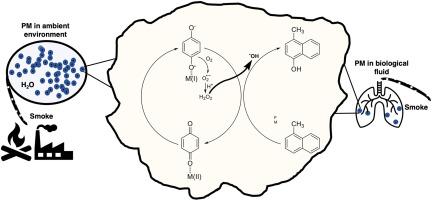Chemosphere ( IF 8.1 ) Pub Date : 2023-08-28 , DOI: 10.1016/j.chemosphere.2023.140002 Ajit Ghimire 1 , Farhana Hasan 1 , Xia Guan 1 , Phillip Potter 1 , Chuqi Guo 1 , Slawo Lomnicki 1

|
Studies of the environmental fate through the interactions of particle-associated polycyclic aromatic hydrocarbons (PAHs) with environmentally persistent free radicals (EPFRs) are presented. The formation of PAHs and EPFRs typically occurs side by side during combustion-processes. The laboratory simulation studies of the model PAH molecule 1-Methylnaphthalene (1-MN) interaction with model EPFRs indicate a transformational synergy between these two pollutants due to mutual and matrix interactions. EPFRs, thorough its redox cycle result in the oxidation of PAHs into oxy-/hydroxy-PAHs. EPFRs have been shown before to produce OH radical during its redox cycle in aqueous media and this study has shown that produced OH radical can transform other PM constituents resulting in alteration of PM chemistry.
In model PM, EPFRs driven oxidation process of 1-MN produced 1,4-naphthoquinone, 1-naphthaldehyde, 4-hydroxy-4-methylnaphthalen-1-one, and various isomers of (hydroxymethyl) naphthalene. Differences were observed in oxidation product yields, depending on whether EPFRs and PAHs were cohabiting the same PM or present on separate PM. This effect is attributed to the OH radical concentration gradient as a factor in the oxidation process, further strengthening the hypothesis of EPFRs’ role in the PAH oxidation process.
This finding is revealing new environmental role of EPFRs in a natural degradation process of PAHs. Additionally, it points to implications of such PM surface chemistry in the changing mobility of PAHs into an aqueous medium, thus increasing their bioavailability.
中文翻译:

基于颗粒物 (PM) 表面环境持久性自由基 (EPFR) 和 PAH 协同作用的氧化 1-甲基萘
本文研究了通过颗粒相关多环芳烃 (PAH) 与环境持久性自由基 (EPFR) 相互作用的环境归宿。PAH 和 EPFR 的形成通常在燃烧过程中并排发生。模型 PAH 分子 1-甲基萘 (1-MN) 与模型 EPFR 相互作用的实验室模拟研究表明,由于相互和基质相互作用,这两种污染物之间存在转化协同作用。EPFR 通过其氧化还原循环导致 PAH 氧化成氧/羟基 PAH。EPFR 之前已被证明在水性介质中的氧化还原循环中会产生 OH 自由基,这项研究表明,产生的 OH 自由基可以转化其他 PM 成分,从而导致 PM 化学改变。
在模型 PM 中,EPFRs 驱动 1-MN 的氧化过程产生 1,4-萘醌、1-萘醛、4-羟基-4-甲基萘-1-酮和(羟甲基)萘的各种异构体。观察到氧化产物产率的差异,具体取决于 EPFR 和 PAH 是共存于同一 PM 还是存在于不同的 PM 上。这种效应归因于 OH 自由基浓度梯度作为氧化过程中的一个因素,进一步加强了 EPFR 在 PAH 氧化过程中的作用的假设。
这一发现揭示了 EPFRs 在 PAHs 自然降解过程中的新环境作用。此外,它还指出了这种 PM 表面化学在改变 PAH 向水性介质中的迁移率方面的作用,从而提高了它们的生物利用度。





















































 京公网安备 11010802027423号
京公网安备 11010802027423号